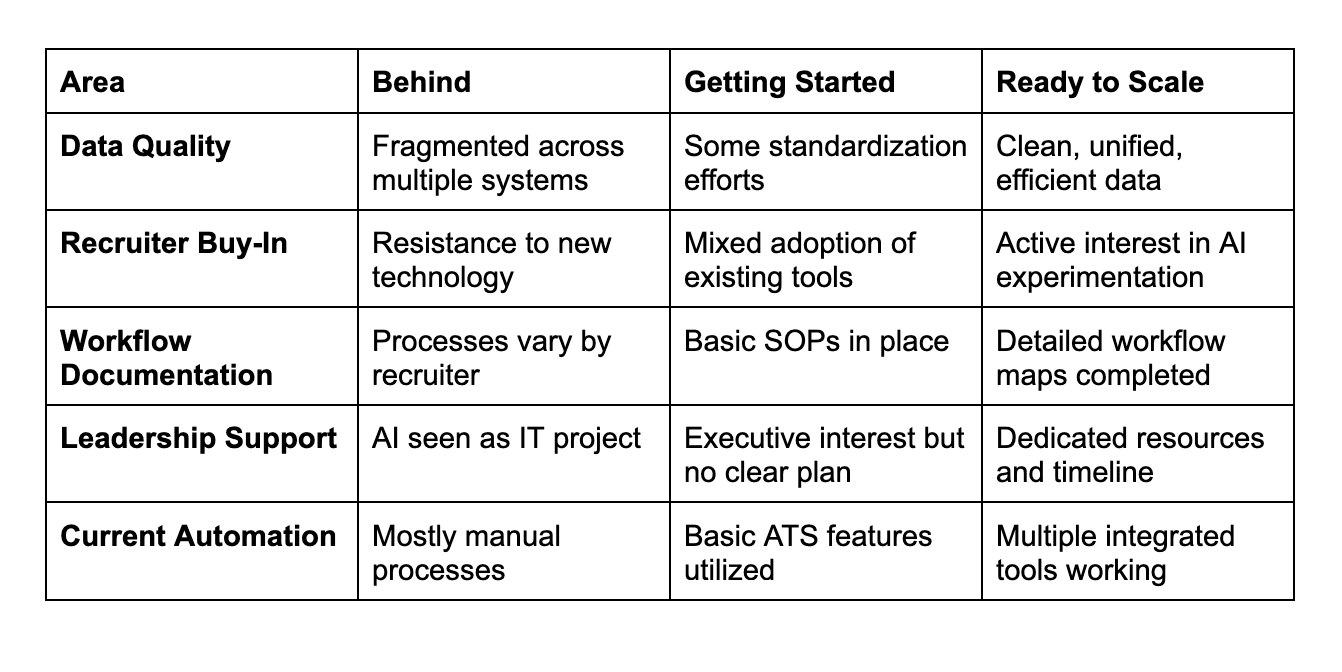AI is not some magic cure for your firm’s troubles. If your workflows are broken, AI will just amplify the mess. AI tools are only as effective as the people who guide them, and in staffing, that means your recruiters. Yet most organizations are doing the opposite: buying AI tools without employee input, then wondering why adoption stalls when they should be prioritizing recruiter-led AI implementation.
Over the next three years, 92 percent of companies plan to increase their AI investments, but only 1 percent call their companies “mature” on deployment.¹ This means AI initiatives deliver measurable business results and improved operational efficiency.
However, the gap between AI investment and AI success isn’t the technology itself. It’s whether your recruiters are leading the implementation or fighting against tools that someone else picked for them.
Why Most Internal AI Hiring Tools Miss the Mark
Digital transformation doesn’t mean blindly buying the latest AI tools and hoping your team adapts. When technology decisions are made in executive boardrooms rather than with input from the recruiters who will use them daily, even the most advanced AI for staffing firms becomes expensive, unused software gathering dust on digital shelves.
Here’s what typically goes wrong when AI implementation happens without recruiter input:
Misaligned Tool Selection
IT departments purchase AI tools based on vendor presentations, not actual recruiting workflows. The result? Software that solves theoretical problems while ignoring real, daily friction points that slow down placements.
Generic Training Data
AI gets trained on industry-wide datasets instead of your firm’s specific decision patterns. This creates recommendations that feel disconnected from how your recruiters evaluate candidates and make placement decisions.
Workflow Disruption
Instead of streamlining existing processes, poorly implemented AI creates additional steps. Recruiters end up managing both their old workflows and new AI tools, doubling their administrative burden.
No Continuous Improvement
Without recruiter feedback loops, AI tools can’t learn and adapt to your firm’s evolving needs. The technology remains static while your business requirements change, creating a widening gap between tool capabilities and actual utility.
The Recruiter-Led AI Implementation Framework
Building internal AI recruitment tools that support your recruiting team requires a fundamentally different approach. Most companies lack the implementation capabilities to move AI beyond the proof-of-concept stage. Only 26 percent successfully generate tangible value from their AI investments.² Meanwhile, 48 percent of employees want more organizational support for using AI effectively.³
Instead of starting with technology selection, begin with the people who will use these tools daily. Here’s how to deploy AI in a way that drives adoption and delivers ROI for staffing firms.
Read More: Using AI to Improve Your Staffing Operation
Start with Workflow Audits, Not Tool Shopping
Before evaluating any recruiter-led AI solution, map your current recruiting processes from initial sourcing to final placement. This isn’t about documenting what your workflows should look like. It’s about understanding what happens.
Shadow your recruiters for a week. Track how much time they spend switching between systems, manually updating candidate statuses, or recreating data that already exists elsewhere.
Identify the actual pain points versus the assumed ones. Leadership might think the biggest problem is candidate sourcing, while recruiters are drowning in administrative tasks between their ATS and VMS platforms. Quantify time spent on repetitive activities that could be automated. A recruiter spending 90 minutes daily on data entry represents nearly 8 hours per week of potential productivity gains.
These workflow audits reveal where AI can create immediate impact versus where it might add unnecessary complexity.
Let Recruiters Define Success Metrics
Your recruiters already know what good candidate matching looks like. They probably just haven’t articulated it in terms that an AI system can understand. Instead of imposing external metrics, work with your team to define what success means in their daily work.
- What candidate characteristics signal a strong cultural fit?
- Which sourcing channels consistently produce quality placements?
- How do successful client communications differ by industry or role type?
- What red flags do experienced recruiters spot that aren’t obvious on paper?
Document the communication patterns that work with different client types. Some hiring managers prefer detailed candidate summaries, while others want quick bullet points highlighting key qualifications. These preferences aren’t captured in generic AI training data, but they’re critical for maintaining client relationships.
When recruiters define these success criteria upfront, internal AI recruiting tools can be trained to replicate these proven approaches rather than creating new processes your team has to learn.
Pilot with Power Users, Not Everyone
Rolling out recruiter-led AI across your entire team simultaneously is a recipe for resistance and confusion. Instead, identify recruiters who are naturally inclined to experiment with new technology. These power users become your internal champions who can troubleshoot issues and demonstrate value to more cautious team members.
Start with one specific workflow rather than trying to automate everything at once. Maybe it’s candidate screening for a particular job type, or automated follow-up sequences for passive candidates. Build confidence and demonstrate clear value before expanding scope.
Your early adopters will identify unexpected use cases and workflow improvements that you can incorporate before broader deployment. This approach also allows you to refine training and support materials based on real user feedback.
Train AI on Real Decisions, Not Generic Data
The most effective AI for your staffing firm learns from your actual placement history, not industry-wide datasets. Use your firm’s historical data to train AI systems on what successful placements look like in your specific market segments.
Train your AI on:
- Historical placement data showing successful vs. failed hires
- Client feedback patterns that predict long-term satisfaction
- Recruiter notes explaining why certain candidates were prioritized
- Communication sequences that led to faster hiring decisions
- Sourcing strategies that work for specific job types or market segments
Build in continuous feedback loops where recruiters can flag when AI recommendations miss the mark. This creates a learning system that gets smarter over time rather than remaining static.
Include both positive and negative examples in your training data. Document not just successful placements, but also candidates who seemed perfect on paper but didn’t work out, and why. This nuanced training data helps AI tools make more sophisticated recommendations that reflect real-world complexity.
Deploy Gradually with Constant Feedback
Successful deployment of internal AI-driven recruitment tools happens in phases, not all at once. Roll out to small teams first, measuring adoption rates alongside efficiency gains. A tool that saves time but nobody uses isn’t delivering value.
Track how frequently recruiters engage with AI recommendations and which features get ignored. Adjust based on user behavior rather than forcing adoption of underutilized features. If recruiters consistently override AI candidate rankings, that’s data indicating the algorithm needs refinement, not user training.
Regular feedback sessions help identify friction points before they become adoption barriers, ensuring your recruiter-led AI implementation supports rather than disrupts productive workflows.
Read More: From AI Confusion to Competitive Edge: A Practical Playbook for Staffing Leaders
Where Does Your Firm Stand?
Here’s a quick AI readiness check

Ready to Build AI That Fits Your Workflows?
Building recruiter-led AI isn’t a weekend project you can tackle between placements. It requires deep expertise in both staffing workflows and AI implementation, capabilities most firms don’t have internally. You need partners who understand how recruiters work, not just how AI theoretically functions.
The difference between AI tools that sit unused and systems that transform productivity comes down to implementation strategy.
Newbury Partners specializes in turning AI theory into recruiting results for staffing firms. We help you audit workflows, identify automation opportunities, and deploy AI tools that your recruiters will use because they helped design them.
Ready to build AI that works with your team instead of against them? Let’s start with an assessment of where your firm stands today.
References
1., 3., Mayer, Hannah, and Lareina Yee. Superagency in the Workplace: Empowering People to Unlock AI’s Full Potential. McKinsey & Company, 28 Jan. 2025, https://www.mckinsey.com/capabilities/mckinsey-digital/our-insights/superagency-in-the-workplace-empowering-people-to-unlock-ais-full-potential-at-work.
2. “AI Adoption in 2024: 74% of Companies Struggle to Achieve and Scale Value.” Boston Consulting Group, 24 Oct. 2024, https://www.bcg.com/press/24october2024-ai-adoption-in-2024-74-of-companies-struggle-to-achieve-and-scale-value.



